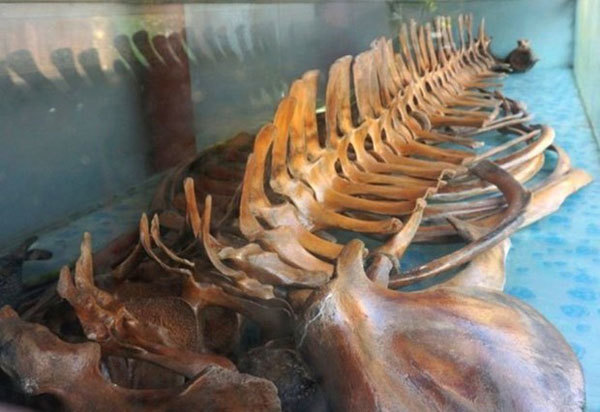(the local respectful name of whale) in Da Loc Commune, Hau Loc District, the north-central coastal province of Thanh Hoa.
 |
| At the temple. (Source: VNA) |
The skeleton was from a gigantic grey whale weighing 40-50 tonnes, whose carcass was discovered in a mangrove forest in Da Loc in early 2005. Soon after they found the dead whale, villagers gathered to hold a funeral for the animal but left the carcass in the forest for a year to decompose.
Locals then mobilised dozens of fishing boats to take the giant whale skeleton to shore, conduct rituals and bring it to a site in the village for worship.
In 2015, the people of Da Loc’s Hung Thanh and Yen Loc villages, and even their relatives who moved away from home for work, made donations to construct the temple and commission the giant glass cabinet.
 |
| The gigantic whale skeleton is preserved in a glass cabinet at the temple. (Source: laodong.vn) |
The temple has been called Ong Nam Hai since then. To date, the skeleton is the biggest of its kind preserved in Thanh Hoa.
Le Van Hai, head of Hung Thanh Village, said that the skeleton is arranged in order from head to tail, with 40 vertebrae, two gill cover bones (or opercula), and 24 bow-shaped ribs.
Each bone is tremendous in size. Before being placed in the glass cabinet, every single one of them was thoroughly cleaned with pure alcohol and then dried in the sun to prevent mould.
The whale skeleton is intact and complete, meaning there is no need for a wooden or stainless steel frame to keep the bones in place. It is one of the most remarkable aspects of this story. Locals simply needed to arrange the bones following the correct positions to form a structure similar to the original shape of the mammal.
Fishermen in Da Loc say the whale temple is sacred and serves as a talisman that keeps local people safe while at sea and helps them obtain bumper catches.
Every January, fishermen in Hung Thanh Village hold their Cau Ngu Festival at the temple. The event is an opportunity for villagers to express their gratitude toward the whale and pray for good weather, a bumper catch, and safe sailing.
Hau Loc, a fishing district, includes five coastal communes Minh Loc, Hung Loc, Ngu Loc, Da Loc, and Hai Loc.
The district’s whale worship goes back for hundreds of years and occupies a special position in the spiritual and religious life of the fishing community. To local fishermen, a whale is a guardian and a source of faith when they encounter big waves and strong winds at sea.
Legend has it that after carrying a seafarer in distress to shore, a whale ran aground and died. Local people then set up a temple in the hope of always being protected by the whale during their journeys away from shore.
At first, Hau Loc people worshipped the whale in a small shrine but then, in 1739, locals in Diem Pho Village found a whale carcass nearly 20 metres long and weighing close to 20 tonnes near a local beach. Considering it a good omen, villagers took their boats out to bring it to shore. However, the whale’s large size made it impossible for the burial to take place in the usual way.
Villagers decided to organise a funeral for the whale just like one held for a respected elder in the village. The event ran for three days, with people across Hau Loc flocking to the venue to pay their respects.
Sometime later, after the whale’s flesh had been washed away by seawater, dignitaries in the village took the remaining bones and washed them thoroughly with alcohol. The bones were then left to dry.
A shrine was then built in the village to worship the whale.
Source: VNA



